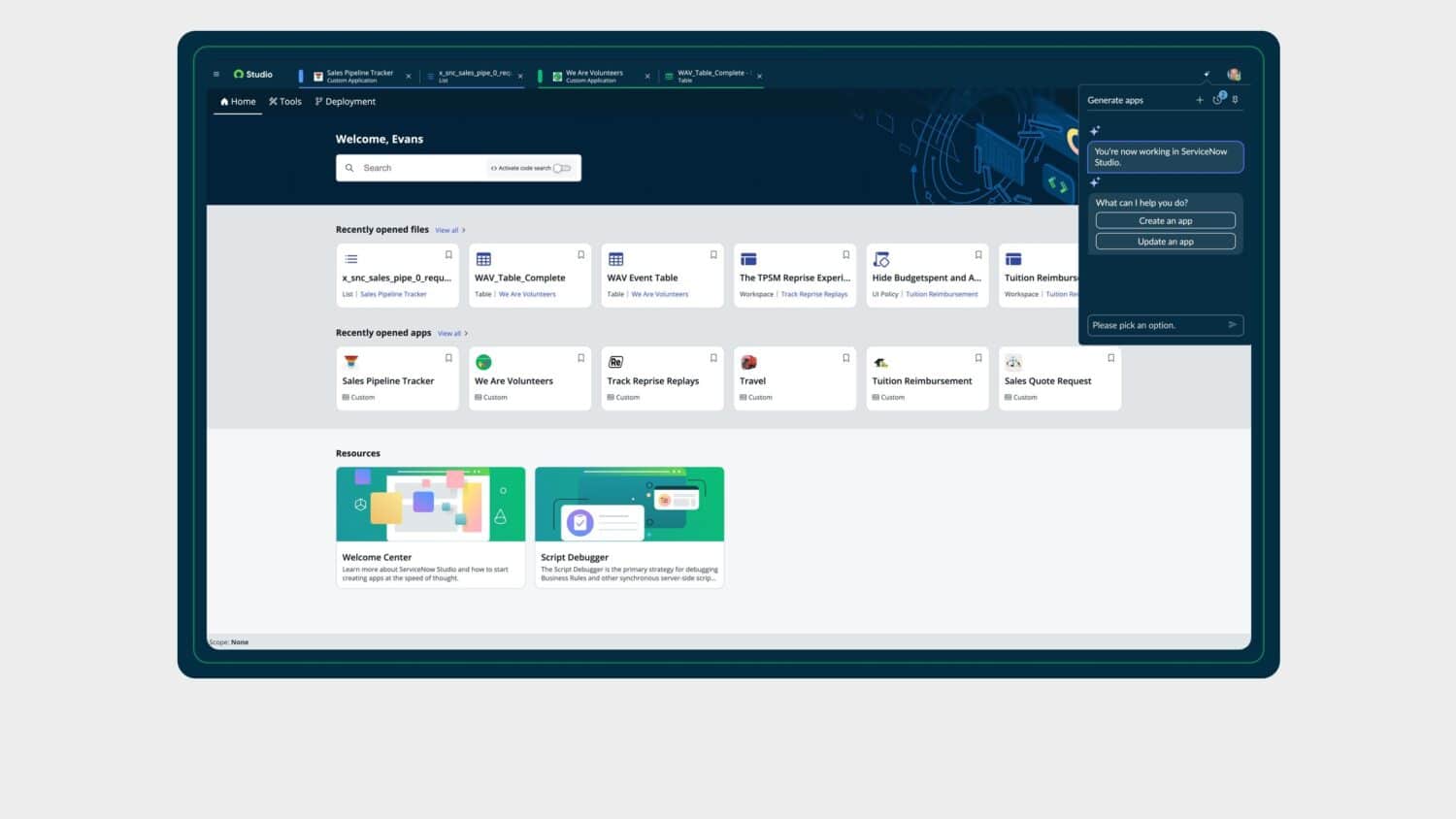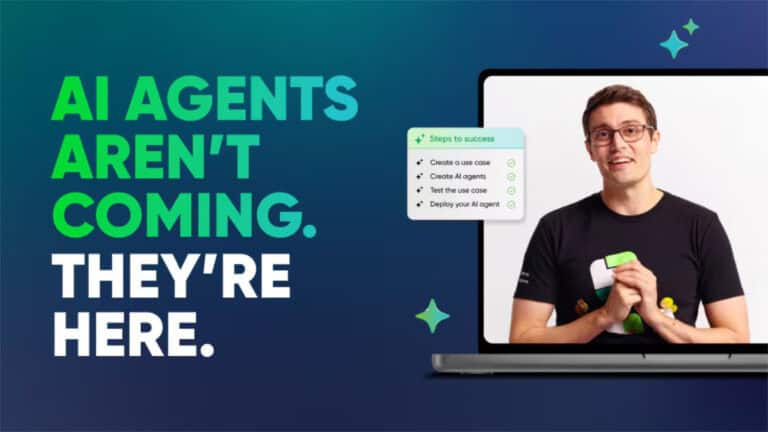With the launch of Yokohama, ServiceNow is choosing to add AI functionalities to almost its entire platform. The Now platform is becoming more and more an AI platform. The goal is to take the work away from the user and IT administrator. ServiceNow claims to become the AI control tower of AI agents with the Now platform.
ServiceNow customers will have to adopt to a new way of working with the Now platform. The addition of AI can speed up many things on the Now platform, though it requires a different approach and, in some cases, a different licensing model. ServiceNow works with three tiers; only in the highest tier do you get all the AI functionality.
The addition of AI to the Now platform means that you can now automate things you previously had to do by hand. Whether you’re building applications, RPA bots, workflows, or AI agents, everything is AI-driven.
Also read: ServiceNow adds hundreds of AI features with Xanadu and confirms Agentic AI
AI agents (partially) autonomous
In addition, the broad introduction of (autonomous) AI agents in Yokohama means that a lot of work can be taken off your hands with the right AI agent. In IT operations, for example, ServiceNow gives an example in a demo of an AI agent that can do network diagnostics.
IT AI agent
IT administrators are now used to getting support tickets from employees experiencing network problems or specific applications being unavailable or barely accessible. Then, the IT administrator has to look for the cause of the problem and a solution. By setting up an AI agent for this purpose, this is no longer necessary. That AI agent can monitor all logs and any support tickets. Suppose a configuration change was made the day before and the network no longer functions properly as a result, the AI agent will detect this and create a ticket for the IT administrator asking if he may reverse the change.
This gives the IT administrator an overview of the problem, what the AI agent thinks the cause is, and the option to allow the AI agent to run an action to fix the problem. The IT administrator can then grant permission to make the change with the click of a button.
For simple support tickets where the IT administrator is confident that the AI agent can resolve it independently, he can make the AI agent fully autonomous without a control step. This can be done, for example, if the impact is lower or if the cases are very clear, such as a password reset or the installation of an application.
Increase impact of Now platform
This move toward much more AI greatly increases the impact of the Now platform. Organizations can now automate business processes much faster, thereby increasing their productivity. ServiceNow hopes to engage organizations in using the Now platform as their primary AI agent platform so that they can live up to that role as an AI Agent control tower.
Building Workflows with AI
Many things organizations used to do with workflows on the Now platform can now be done by AI agents. According to ServiceNow, the AI agents’ actions are predictable enough to rely on them. Should you as an organization still want 100 per cent assurance, you can also use AI to build a workflow. With an English text description, you can specify what kind of workflow you want to build, what steps it should go through, what systems it should consult, and the AI will generate the workflow for you. You can afterwards modify the workflow in the no-code editor.
Building applications, RPA bots and AI agents with AI
The same applies to building applications, RPA bots and AI agents. Everything is AI-driven and can be fed through a standard text description to an AI to build your application, RPA bot or AI agent. Customization is done via no-code, low-code or by issuing additional commands to an AI, which then adjusts the part that was just built.

AI Agent Studio and ServiceNow Studio
The AI Agent studio has been developed for AI agents. In this studio, any ServiceNow user can build their own AI agent. Building AI agents is very easy, especially if ServiceNow already offers certain agents with similar expertise.
The ServiceNow Studio generates applications with AI. The ServiceNow Studio is also easy to use, but a bit more complicated than the AI Agent Studio in our opinion. We see in ServiceNow demos that some technical knowledge is still required. For example, when generating an application, the user indicates which database tables it affects. With that, building applications seems more like something for a Now administrator than an everyday user. However, this demo does show that building applications is fairly comprehensive. For example, the AI agent asks if certain functionalities should be added to the application. So, the AI agent is already thinking about how such an application will be used and what kind of features might be helpful in the process.
Hundreds of AI agents with all kinds of specializations
ServiceNow has designed all kinds of AI agents with specializations to take work off your hands more quickly. For example, a Security Operations AI Agent is capable of monitoring an organization’s cybersecurity and managing the entire incident lifecycle.
Or what about an Autonomous change management AI agent or a Proactive network test & repair AI agent. There are many more AI agents for IT operations, CRM and HR processes.

Orchestration agent in AI control tower makes the difference
Many organizations think that if they tie the right data to the right LLM via RAG, they can get quick results with AI. Unfortunately, that’s not the case. That only works for simple use cases. As soon as you start working with larger amounts of data or more complex data, the chances of an AI agent messing up becomes bigger and bigger. The same applies when you start working with sensitive data, where governance and compliance come into play.
Big platforms like ServiceNow and Salesforce, for example, have therefore built an extra layer between the AI agents and the LLMs that have to do the work. This extra layer consists of several components. At SericeNow, this is an orchestration engine, which can be compared to Salesforce’s reasoning engine and an AI governance and security engine.
The orchestration engine analyzes the job and then links it to the appropriate AI agent. In addition, the orchestration engine also looks at what data an LLM then returns to see if that meets the stated requirements of the assignment. It can do this because it has all the integrations, data, processes, and incidents that have occurred on the ServiceNow platform. If something is wrong to the liking of the orchestration engine, it will reissue the job to the LLM to make corrections. Also, the orchestration engine can intervene if a process gets stuck somewhere. If everything is satisfactory, the AI governance and security engine emerges. It checks whether all requirements are met regarding security and data privacy. So, this orchestration engine plays a huge role in how the AI agents on the Now platform work and function. That’s the heart of ServiceNow’s entire AI strategy.
Knowledge graph
With the release of Yokohama, ServiceNow’s Knowledge Graph has once again expanded significantly. However, we understand from conversations with ServiceNow that it is still under development. Over the last year, ServiceNow has revamped its entire data architecture. The database architecture has been converted from MariaDB to RaptorDB, the latter being a PostgreSQL-based database with optimizations for the ServiceNow platform.
Beyond that, ServiceNow is now also building a knowledge graph of data and metadata to provide all AI models and agents with even better data sets. Hence, the context of the data is also more precise.
ServiceNow customers should upgrade to RaptorDB
If customers are not using RaptorDB, they must upgrade before taking advantage of all the AI capabilities the Now platform offers. For many customers this is not a problem, they can upgrade fairly easily, only customers who have been using the Now platform for more than five years and have made modifications in the source code or core of the platform face a major challenge. They have to go to the fit-to-standard principle before they can upgrade. That means a bit more work, but that’s an industry standard these days, it immediately guarantees that you can always quickly update to the latest stack and feature set from then on.
Data Fabric
Regarding using data, it doesn’t stop with RaptorDB and the Knowledge Graph. ServiceNow also has a whole load of connectors with zero-copy support. This allows you to connect data directly to the Now platform that resides in Snowflake, Databricks or various cloud databases and S3 buckets.
ServiceNow opts for enterprise AI stack
All in all, ServiceNow has developed a nice AI stack that will allow it to help large organizations directly apply AI to many areas of work, from HR to IT operations. The next few months should reveal the adoption rate, how easily customers can apply these AI agents to their own data sets, and the results. We’ll hear more about this at Knowledge 2025, which Techzine will report on in May.
